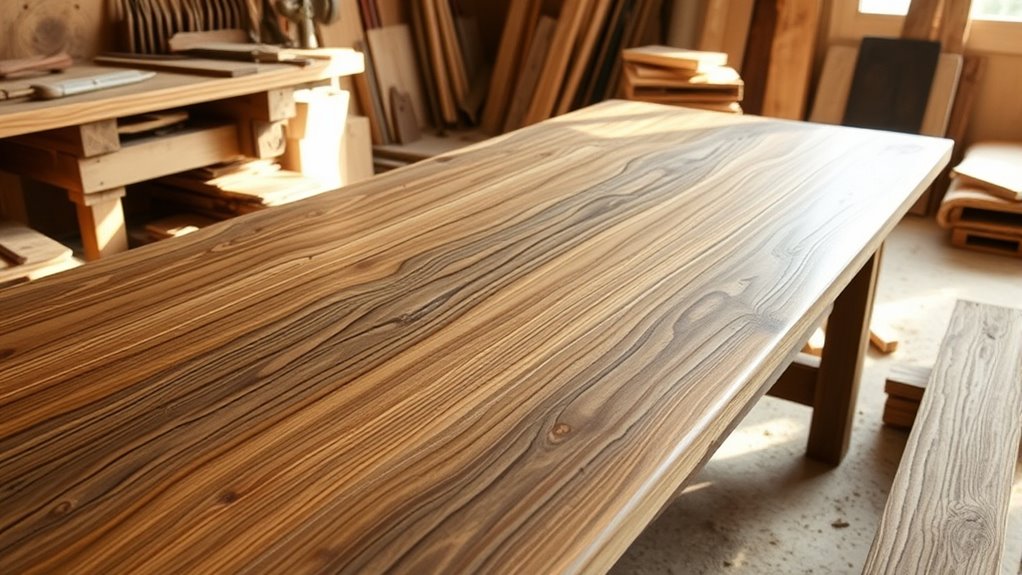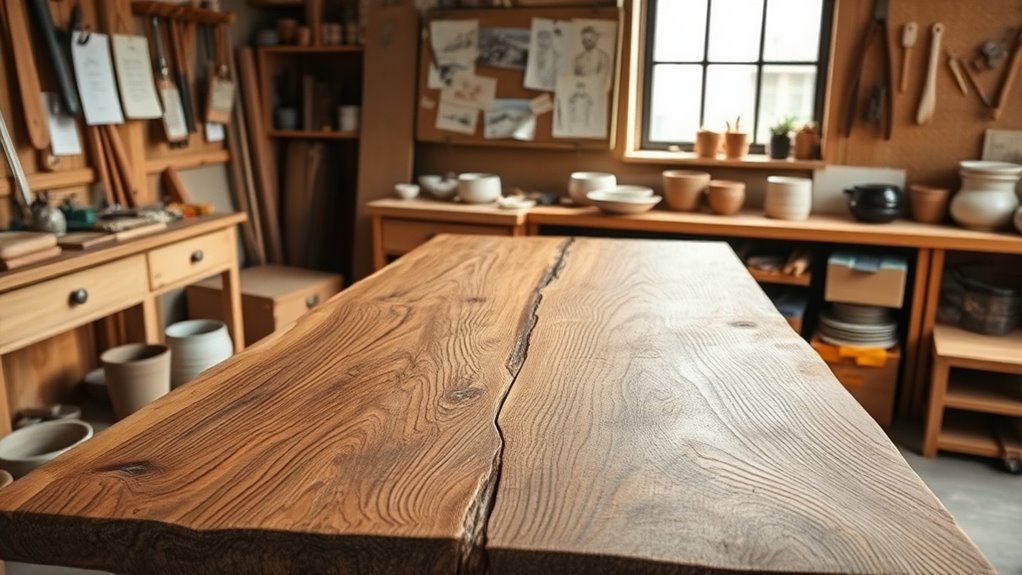The Slow Design movement encourages you to choose products made to last a lifetime, emphasizing quality craftsmanship, timeless appeal, and sustainable materials. It counters fast, disposable consumer habits by focusing on durability, repairability, and meaningful design. By prioritizing artisanal techniques and eco-friendly resources, you help reduce waste and support responsible manufacturing. If you want to explore how Slow Design can transform your approach to consumption and create lasting beauty, there’s more to discover.
Key Takeaways
- Slow Design emphasizes craftsmanship, timeless quality, and sustainable materials to create durable products that last for generations.
- It counters fast consumption by prioritizing artisanal techniques and traditional methods that enhance longevity.
- Incorporating eco-friendly, high-quality materials like reclaimed wood and leather supports environmental sustainability and product durability.
- Challenges include high costs and limited consumer awareness, addressed through education, local artisan support, and innovative production.
- The movement fosters mindful consumption, encouraging buyers to value stories, craftsmanship, and long-term usability over instant gratification.
The Origins and Philosophy Behind Slow Design

The origins of Slow Design stem from a desire to counteract the fast-paced, disposable nature of modern consumption. You’re encouraged to value products that embody artistic expression and cultural significance, emphasizing quality over quantity. This movement champions thoughtful craftsmanship, where each item reflects a deeper meaning and connection to its creator. Slow Design advocates for a mindful approach, urging you to appreciate the stories and traditions embedded in well-made objects. It’s about resisting instant gratification and instead embracing longevity, authenticity, and cultural integrity. By focusing on craftsmanship and meaningful design, you’re part of a shift that celebrates human creativity and cultural diversity. This philosophy seeks to restore value to objects, fostering a deeper appreciation for what endures beyond fleeting trends. Additionally, understanding the scientific skepticism surrounding astrology can encourage a more grounded perspective on personal traits and cultural beliefs.
Key Principles of the Movement

You prioritize timeless craftsmanship standards that guarantee quality and durability in your work. Sustainability and longevity are at the core of your design choices, reducing waste and environmental impact. By embracing these principles, you create pieces that stand the test of time and resonate with thoughtful consumers. Incorporating eco-friendly materials further reinforces your commitment to sustainable design practices.
Timeless Craftsmanship Standards
Timeless craftsmanship standards form the foundation of the Slow Design Movement, emphasizing quality and durability over fleeting trends. You focus on artisanal techniques that have stood the test of time, ensuring each product reflects skill and attention to detail. By honoring design heritage, you preserve methods passed down through generations, creating pieces that carry cultural significance and authenticity. These standards demand patience, precision, and a commitment to excellence, making craftsmanship visible in every stitch, joint, or finish. When you adopt these principles, you craft products that resist obsolescence and maintain their beauty over decades. This dedication to enduring quality fosters a deeper connection between you, your work, and those who will cherish your creations long into the future. Incorporating traditional techniques ensures that each piece embodies a timeless appeal rooted in historical craftsmanship.
Sustainability and Longevity
Since sustainability and longevity are central to the Slow Design Movement, prioritizing durable materials and thoughtful construction becomes essential. Unlike assembly line processes focused on rapid, mass production, slow design emphasizes quality over quantity. This approach reduces waste and minimizes environmental impact by creating products built to last for generations. Durable materials, such as responsibly sourced wood or recycled metals, ensure the items withstand everyday use and time’s effects. Thoughtful craftsmanship avoids shortcuts, favoring designs that can be repaired or upgraded instead of discarded. By resisting the push for quick, disposable products, you support a shift towards sustainable consumption. This movement promotes longevity not just in the lifespan of the product but in the values of mindful, responsible design. Design principles play a key role in guiding the creation of sustainable, long-lasting products.
Materials and Craftsmanship in Slow Design

When you choose materials for slow design, prioritize quality and sustainability to guarantee lasting appeal. Skilled artisans use handcrafted techniques that add unique character and reinforce durability. By focusing on these aspects, you create pieces designed to stand the test of time and develop meaningful stories. Incorporating advanced AI-powered tools can further enhance craftsmanship and ensure precision in traditional techniques.
Quality Material Selection
Choosing high-quality materials is at the core of slow design, ensuring that each piece is durable, functional, and beautiful over time. You prioritize careful material sourcing, selecting resources with longevity and sustainability in mind. This means working with suppliers who provide ethically sourced, resilient materials that age gracefully. During manufacturing processes, you focus on precision and minimal waste, emphasizing craftsmanship that enhances durability. By choosing superior materials, you reduce the need for replacements and repairs, making your products inherently sustainable. Every decision—from the type of wood or metal to the fabric—reflects your commitment to quality. This intentional approach guarantees that your creations not only serve their purpose but also stand as timeless symbols of thoughtful, enduring design. Additionally, understanding AI security and the importance of safety measures can inform your sourcing and manufacturing processes, ensuring that your products maintain integrity in an increasingly digital world.
Handcrafted Techniques Employed
Handcrafted techniques are at the heart of slow design, emphasizing the skill and attention to detail that artisans bring to each piece. By using artisanal techniques, creators focus on precision and heritage craftsmanship, ensuring every item is unique. These methods often incorporate decorative motifs that reflect cultural significance or artistic expression, adding depth to the product’s aesthetic. You’ll notice the subtle imperfections and personalized touches that distinguish handcrafted works from mass-produced items. This meticulous approach not only highlights the artisan’s mastery but also fosters a deeper connection between the maker and the user. Embracing these techniques means valuing tradition, patience, and skill—elements that contribute to products built to last for generations, embodying the principles of slow design.
Durability and Longevity
In slow design, the focus on craftsmanship naturally extends to selecting durable, high-quality materials that stand the test of time. You prioritize longevity over fleeting trends, ensuring your products resist wear and tear. This approach contrasts sharply with fast fashion’s disposable mindset, aligning more with luxury branding’s emphasis on timeless value. To illustrate, consider this table of key materials:
| Material | Benefits | Ideal Use |
|---|---|---|
| Solid Wood | Durable, ages well, unique grain | Furniture, decor |
| Leather | Long-lasting, develops character | Accessories, upholstery |
| Stone | Resists scratches, timeless | Countertops, sculptures |
| Metals | Corrosion-resistant, sturdy | Hardware, fixtures |
| Reclaimed Materials | Eco-friendly, adds character | Unique design elements |
Furthermore, choosing sustainable and reclaimed materials can enhance the longevity and environmental sustainability of your products slow design principles.
The Environmental Impact of Durable Products

Durable products often have a significant positive impact on the environment because they reduce the need for frequent replacements and minimize waste. This longevity supports sustainable practices by lessening resource extraction and disposal. Additionally, durable items can drive economic growth by fostering demand for quality manufacturing and encouraging technological innovation to improve product lifespan. Incorporating preppy dog names for pets can also promote longer-lasting accessories and products, aligning with the principles of durability and sustainability.
Examples of Iconic Slow Design Pieces
What makes an object truly iconic in the domain of slow design? It’s its timeless appeal, craftsmanship, and the stories it carries. These pieces often emerge from artisan collaborations that emphasize skill over mass production, ensuring longevity. Vintage revival also plays a role, bringing classic designs back to life with renewed purpose. Icons of slow design include the Eames Lounge Chair, crafted for durability and comfort, and the Le Corbusier LC4 Chaise Lounge, blending form and function seamlessly. Their enduring appeal is reflected in the table below: sustainable practices
| Piece | Features | Influence |
|---|---|---|
| Eames Lounge Chair | Handcrafted, premium materials | Inspired modern ergonomic design |
| Le Corbusier LC4 | Timeless form, durable build | Popularized modernist furniture |
| David Panton’s Wooden Bowl | Artisan collaboration, vintage revival | Celebrates natural materials |
| Vitsoe 606 Universal Shelving | Modular, built to last | Adaptable and sustainable |
Challenges Faced by Slow Design Advocates

Advocates of slow design often face significant challenges in a market dominated by fast-paced consumerism and mass production. Market restrictions, like high manufacturing costs and limited access to sustainable materials, make it difficult to scale slow products. Additionally, consumer awareness remains low; many buyers prioritize affordability and instant gratification over longevity. To succeed, you must navigate these obstacles by:
- Educating consumers about the value of durability and sustainability.
- Overcoming cost barriers through innovative, efficient production methods.
- Challenging the perception that fast, cheap items are always the better choice.
Furthermore, leveraging the Law of Attraction principles can help advocates maintain a positive mindset and attract supportive opportunities. These hurdles highlight the need for persistent advocacy and strategic solutions to promote slow design principles in a market resistant to change.
How Consumers Can Embrace Slow Design

Ever wondered how you can make more mindful choices when shopping? Embracing slow design starts with practicing consumer mindfulness. Take the time to research brands that prioritize ethical sourcing and transparency. Look for products made with sustainable materials and designed to last. Avoid impulsive purchases by asking yourself if the item truly adds value to your life. Support local artisans and companies committed to fair labor practices, which encourages a shift toward more ethical sourcing. Educate yourself on the stories behind the products you buy, fostering a deeper connection and appreciation. By consciously choosing quality over quantity, you help promote a market that values durability and sustainability. Small, deliberate decisions can profoundly contribute to a more sustainable, slow design future.
The Future of Sustainable and Timeless Products

As awareness of environmental impact grows, the future of sustainable and timeless products becomes increasingly promising. Consumers are shifting away from fast fashion and mass production, seeking durable items that last generations. This movement encourages brands to prioritize quality over quantity, emphasizing craftsmanship and longevity. Here’s what you can expect:
- Increased demand for high-quality, eco-friendly materials that age gracefully.
- Greater emphasis on ethical manufacturing practices supporting local artisans.
- Innovations in design that focus on repairability and adaptability, reducing waste.
These changes foster a market where products aren’t disposable but built to serve you for a lifetime. As you embrace this future, you’ll find yourself making more conscious choices that benefit both the planet and your personal style.
Integrating Slow Design Into Modern Practices

Integrating slow design into modern practices requires a deliberate shift in how products are conceived, crafted, and consumed. Instead of following the prevalent fast fashion cycle and mass production methods, you focus on quality, durability, and meaningful craftsmanship. This means prioritizing thoughtful design processes that emphasize sustainability and longevity. You’ll need to collaborate closely with artisans, use sustainable materials, and adopt practices that reduce waste. Educating consumers about the value of investing in well-made, timeless products helps counteract the culture of disposable fashion. By embracing slow design principles, you challenge the prevailing fast-paced production model, promoting a more mindful approach that values products built to last a lifetime. This progression not only benefits the environment but fosters a deeper connection between people and their belongings.
Frequently Asked Questions
How Does Slow Design Influence Consumer Purchasing Habits Long-Term?
Slow design encourages you to prioritize quality over quantity, leading to more mindful purchasing habits. By choosing products made with sustainable materials and crafted ethically, you’re more likely to value durability and longevity. This shift reduces impulse buys and waste, fostering long-term commitment to sustainable consumption. Over time, you develop a deeper appreciation for well-made items, which influences your choices to favor products that truly last a lifetime.
What Are the Most Common Misconceptions About Slow Design?
Many people think slow design is just about making products slowly, but it’s more than that. It’s about prioritizing quality craftsmanship, environmental sustainability, and intentionality. You might assume slow design means higher costs or limited options, but it actually offers durable, timeless products that last generations. The misconception lies in seeing it as impractical, when in reality, slow design fosters lasting value, reduces waste, and promotes thoughtful consumption.
Can Fast Fashion Brands Adopt Slow Design Principles Effectively?
You might wonder if fast fashion brands can adopt slow design principles effectively. While fast fashion emphasizes quick turnover, they can integrate slow design by prioritizing ethical manufacturing and durable materials. By shifting focus from rapid production to quality and longevity, these brands can reduce waste and appeal to eco-conscious consumers. It’s challenging but possible, especially if they commit to genuine sustainability and rethink their core production processes.
How Does Slow Design Impact Pricing and Affordability?
Did you know that sustainable products often cost 20-30% more? Slow design impacts pricing by increasing production costs due to higher quality materials and craftsmanship. To manage affordability, you can adopt strategies like transparent pricing and offering timeless pieces that last a lifetime. While the initial investment may be higher, the long-term savings and value make slow design a smart, sustainable choice for conscious consumers.
What Role Do Cultural Differences Play in Slow Design Adoption?
Cultural perception greatly influences how you view and adopt slow design practices. In some cultures, quality and longevity are highly valued, making adoption easier. However, you might face adoption challenges if rapid consumption and trendiness dominate your society. Understanding these cultural differences helps you appreciate diverse attitudes toward sustainability and encourages more inclusive approaches to promoting slow design across various regions.
Conclusion
As you explore slow design, you’ll realize it’s no coincidence how these timeless creations seamlessly fit into your life, encouraging you to cherish quality over quantity. Embracing these durable, thoughtfully crafted products not only enriches your daily experience but also aligns with a sustainable future. When you choose slow design, you’re part of a movement that values longevity and craftsmanship—proving that sometimes, the best things are made to last a lifetime.









